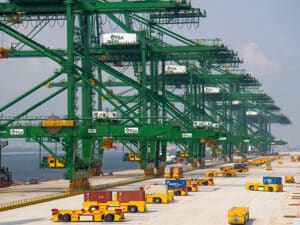
Op-Ed: Midwest resources can ease shipbuilding labor constraints
Written by Heather Ervin
George Whittier, Fairbanks Morse Defense CEO
By George Whittier, Fairbanks Morse Defense CEO
The U.S. shipbuilding industry is at a critical juncture, with China’s dominance in capacity and efficiency posing significant challenges to national defense.
China currently has 232 times the U.S.’s shipbuilding capacity. Not only does China produce more than 50% of the commercial ships currently in use globally, but its Navy has 370 ships compared to a U.S. fleet of 291 surface combatants, submarines, aircraft carriers, and other vessels.
China’s staggering shipbuilding output, coupled with its formidable Navy, underscores the urgency for the U.S. to bolster its shipbuilding capabilities.
Skilled labor shortages are a primary obstacle hindering U.S. shipbuilding efforts, resulting in delays and impacting crucial Navy programs. High retirement rates, particularly among skilled nuclear shipbuilders, exacerbate this issue, compounded by difficulties recruiting and retaining younger workers. Traditionally, young jobseekers have relocated to the cities for higher-paying jobs and better opportunities. But that’s no longer the case. There are plenty of opportunities for rural residents that don’t require them to relocate to the major cities or coastal areas where the major shipyards are located.
The repercussions of labor shortages are evident in the U.S. Navy’s recent budget adjustments, reflecting reduced ship funding. While the Navy has been funding 10-12 ships annually, only six ships will be funded by the FY 2025 budget. At the same time, 19 will be decommissioned. This sends the wrong demand signal to the defense industrial base at a time when it’s trying to convince workers that shipbuilding is a lucrative and worthwhile career. It also sends the wrong message globally during a time when the geopolitical environment is growing more tense.
While this challenge is difficult, it’s not insurmountable. It simply requires a new approach.
Leveraging the Midwest’s underutilized labor resources presents an opportunity to revitalize U.S. shipbuilding. Midwest defense contractors exhibit resilience to labor challenges, suggesting untapped potential for ship component manufacturing. Building components in St. Louis and then utilizing the Mississippi River as a transportation corridor to streamline logistics can facilitate the seamless integration of components into shipyards.
Furthermore, small and mid-sized shipyards present viable alternatives, circumventing labor constraints plaguing larger counterparts similar to building components in the Midwest. These components can be transported to larger shipyards, turning them into assembly plants so they can focus constrained labor resources on expediting the production of critical platforms such as amphibious vessels and submarines. The approach has been successfully used by the automotive industry for decades, promising immediate gains in accelerating shipbuilding timelines.
Calls for an overarching shipbuilding strategy resonate, underscoring the urgent need for increased budgetary allocations, infrastructure investments, and political commitment. The importance of collaboration among the Navy, Congress, and industry stakeholders cannot be overstated. It is this collective effort that will realize the vision, revitalizing the U.S. shipbuilding sector and reaffirming maritime strength on the global stage. It is imperative to act decisively, rallying collective efforts toward restoring national pride in this cornerstone American industry.




